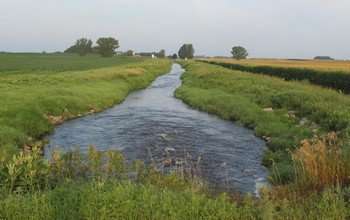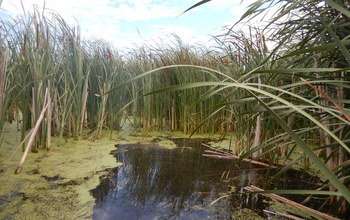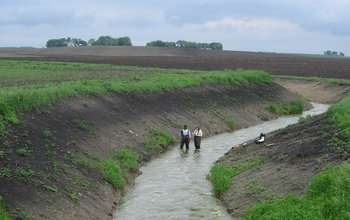Agricultural ditch with a field of corn on one side and soybeans on the other. Credit: Katie Kemmit
In agricultural regions such as the U.S. Midwest, excess nitrate from crop fertilizer makes its way into rivers and streams through subsurface drainage channels and agricultural ditches.
High nitrate concentrations in waterways can be harmful to ecosystems and human health, contaminating drinking water and eventually flowing downstream far enough to increase the size of the Gulf of Mexico's "dead zone."
A study published today in the journal Nature Geoscience by National Science Foundation (NSF)-funded researchers offers new insights into this problem: Multiple wetlands, or "wetland complexes" in a watershed, are extremely effective at reducing nitrate levels in rivers and streams.
Wetland complexes can be five times better at reducing nitrate than the best land-based nitrogen mitigation strategies, the scientists say.
"Agricultural productivity benefits the economy, but is often accompanied by environmental costs," says Tom Torgersen, director of NSF's Water, Sustainability and Climate program, which funded the research. "This study demonstrates that retaining or restoring wetlands in intensively managed agricultural watersheds would reduce nitrate in rivers and improve local water quality, while also reducing nitrate exports to the Gulf of Mexico hypoxic [dead] zone."
Wetlands are important for reducing excess nitrate flowing downstream. Credit: Amy Hansen
Using water samples collected over a four-year period from more than 200 waterways in the 17,000-square-mile Minnesota River Basin (MRB), along with geospatial information on land use in the MRB watershed, researchers isolated the effects of wetlands on stream and river nitrate concentrations.
The research produced a number of significant findings:
- When stream flows are high, wetlands are five times more efficient at reducing nitrate than the best land-based conservation practices.
- The arrangement of wetlands in a watershed is a predictor of the magnitude of nitrate reduction. When wetlands filter runoff from 100 percent of a drainage area, they are three times more effective at nitrate removal than when they filter runoff from 50 percent of a drainage area.
- Nitrate reduction in temporary wetlands and in geographically isolated wetlands (those not connected to a river), such as wetlands that form in agricultural ditches, is largest during high stream flows.
"These are important steps toward recognizing that as we lose wetlands, we also lose the significant benefits they provide in pollution control," says Amy Hansen, a researcher at the University of Minnesota's St. Anthony Falls Laboratory and first author of the journal paper.
Scientists measure water velocity and collect samples in an agricultural ditch. Credit: Amy Hansen
The contributions of small wetlands are especially important for the future, Hansen says. Climate forecasts predict increases in precipitation frequency and magnitude—conditions under which wetlands play a significant role in reducing river nitrate.
"Our work shows that wetland restoration could be one of the most effective methods for improving water quality in the face of climate change and the increasing global demand for food," says paper co-author Jacques Finlay, an ecologist at the University of Minnesota.
Other co-authors of the paper are Christine Dolph of the University of Minnesota and Efi Foufoula-Georgiou of the University of California, Irvine.
The results of the research are advancing scientists' understanding of wetlands and their role in pollution control, according to the researchers, and providing guidance on wetland restoration siting and benefits.
More information: Amy T. Hansen et al. Contribution of wetlands to nitrate removal at the watershed scale, Nature Geoscience (2018). DOI: 10.1038/s41561-017-0056-6
Journal information: Nature Geoscience
Provided by National Science Foundation
























